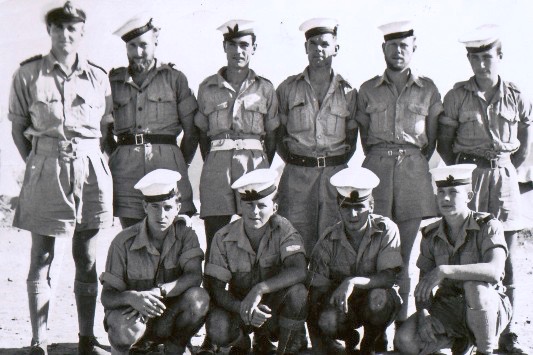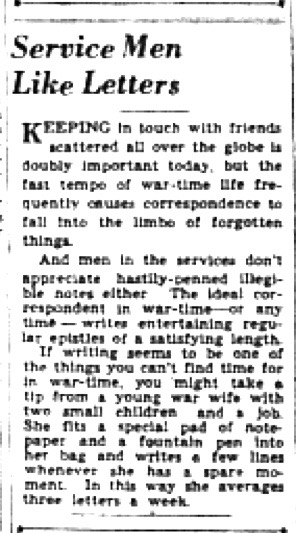Monday, September 6, My Dad's Birthday.
Monty's 8th Army Successfully Lands on the Toe of Italy
On September 6, 1943 my father turned 23-years-old and likely spent the day delivering men and materiel of war in heavily-laden Landing Crafts (LCMs) across the Strait of Messina. On return trips he may have seen many prisoners of war and people of all ages waving white handkerchiefs. They were not celebrating his birthday, though they may have been wishing him well, along with all of the other members of Allied forces, and demonstrating their joy that German forces were being pushed north along the Italian Peninsula.
Whatever the case, I say "Happy birthday, Dad! Keep your head down."
British, Canadian and Soviet forces made the news on Sept. 6, as did the heavy bombings taking place in some of Germany's vital centres.
A report from Canadian War Correspondent Ross Munro (Thrilling Story of Invasion) puts us right up close to the Canadian Navy boys who were operating the landing crafts at this time in Italy.
Here are some photos and news items from The Montreal Star:
These smiling Canadians are in Kiska, Alaska
Canadian troops, likely delivered to Italy in some of the Canadian landing crafts for the first time, are working alongside of Monty's 8th Army:
Ross Munro, a prolific writer, accompanied Canadian troops. The small italics print below says the following: (In the following dispatch Ross Munro, Canadian Press war correspondent, describes the sea crossing from Sicily to Italy as the invasion was launched and the first phases of the assault.)
About the article above: Mr. Munro mentions Matthew Halton of the CBC. Matthew's son David also worked for the CBC at a later date and put stories related to his father in a very good book entitled "Dispatches from the Front." (link)
Matt Halton, far left. Photo as found in Dispatches From the Front.
Munro also mentions that he was on board a Canadian landing craft under the command of "Lieut. Jack Coyle of Saskatoon". I have seen three spellings for J. Coyle, Koyl, Koyle.
My father called him Uncle Jake, with the officer's permission, and has written two stories about him. Koyl is also mentioned in news articles found in The Winnipeg Tribune re the earlier invasion of Sicily along with a few sailors who were my father's mates. Contact the Editor at gordh7700@gmail.com for more details re J. Koyl.
We also see the name Don Filmore, from Stellarton, Nova Scotia, a field wireless operator. Let's call that a good lead for more information, for those that do research in that area.
The photo below gives us a good look at Lieut. J. Koyl and several members of the Canadian landing craft flotillas:
The photos below give us a look at a few members of RCNVR and Combined Ops on their way around Africa on their way to the invasions of Sicily and Italy. They are aboard HMS Keren.
Several of the above served at HMCS Givenchy III at Comox, BC
from 1944 - 1945, along w my father, after the invasion of Italy
Below is more information from the story entitled Combined Operations in Sicily and Italy (Reminiscences of a Canadian LCM Flotilla Engineer Officer) as found in COMBINED OPERATIONS by Londoner Clayton Marks. Here we read more about the camp that Canadians stayed in after arriving in Egypt after their trip around Africa aboard, e.g., HMS Keren, S.S. Silver Walnut, etc.
Our first land base in the Middle East presented a grim exterior. Tents, tents, sand, tents, sand and more sand met the eye beyond an unimposing but sturdy 'HMS Saunders' sign-board. Imagine the extreme change of environment from a ship's decks to a barren waste of sand! And though it was only the beginning of May, the heat was most oppressing. So with sadly dejected spirits the boys dumped their micks and kit bags off the trucks at the Quartermaster's tent.
The Officer of the Day assigned the tents and messes and we, satisfied that all was in good order, walked over to the 'Wardroom' tent. Here we were greatly surprised to find a very commodious and comfortable arrangement of several large marquees adjoining each other. The bar was good and long, a feature which is always noted with satisfaction. And surprise of surprises, they had a fair stock of Canadian beer on ice! Gee what a treat after expecting a dim and dreary wardroom. The meals too, were excellent.
Very happy are the memories of that wardroom, for in it we met the other Officers of our Flotilla and other Flotillas as their ships came into the harbour a dozen or so miles distant. There were bull-sessions late into the night during this period as each one gave an account of some particularly interesting occurrence of his trip out from the UK.
Dave*, one of our Officers in charge of a goodly number of Ratings, spent ninety days on the trip, while others of us had arrived in five or six weeks. His particular ship had unfortunately encountered engine trouble and several times they were floating with both engines stopped in the middle of nowhere with probably unknown numbers of enemy subs lurking in the same waters. However, some providence brought them into port safely at last. There was great rejoicing on their arrival, for we had begun to fear that if they did arrive, it would be too late for our first operations.
(*Dave refers to Dave Rodgers. His name appears on a Navy hammock along with with other members of the 80th Flotilla, including Doug Harrison, Ed Corbett and others mentioned in this series of stories from The Med. You don't suppose Dave wrote this story about his own adventures during WW2?)
The above account would lead one to think that this camp, because of its location in a sandy area, would be a rest centre for the whole Flotilla. On the contrary a great deal of hard work was done here, for we had brought our boats to a small lake a short distance away from the camp and each day boats' crews and maintenance staff worked from 0700 till noon and often again in the afternoon. If the afternoons were too hot we adopted tropical hours and did some work in the cool of the evening. I say cool, but I suppose that there was no evening when the perspiration wouldn't roll off one's brow even when standing still. But everyone threw their heart and soul into the job for they all knew that great things would be expected of them and their boats. Previous operations had taught the Officers and men that boats and boat equipment are essentially the heart of the force and if they are not in perfect condition much of the 'punch' is lacking on 'D' day. (Page 90 - 91, Combined Operations)
Later in the same story we read an excerpt that mentions Lieut. Jack or Jake Koyl:
(*Dave refers to Dave Rodgers. His name appears on a Navy hammock along with with other members of the 80th Flotilla, including Doug Harrison, Ed Corbett and others mentioned in this series of stories from The Med. You don't suppose Dave wrote this story about his own adventures during WW2?)
The above account would lead one to think that this camp, because of its location in a sandy area, would be a rest centre for the whole Flotilla. On the contrary a great deal of hard work was done here, for we had brought our boats to a small lake a short distance away from the camp and each day boats' crews and maintenance staff worked from 0700 till noon and often again in the afternoon. If the afternoons were too hot we adopted tropical hours and did some work in the cool of the evening. I say cool, but I suppose that there was no evening when the perspiration wouldn't roll off one's brow even when standing still. But everyone threw their heart and soul into the job for they all knew that great things would be expected of them and their boats. Previous operations had taught the Officers and men that boats and boat equipment are essentially the heart of the force and if they are not in perfect condition much of the 'punch' is lacking on 'D' day. (Page 90 - 91, Combined Operations)
Later in the same story we read an excerpt that mentions Lieut. Jack or Jake Koyl:
Jake had just beached his boat and was engaged in off-loading the vehicle it carried when a dive-bomber attacked the beach. An LCT was unloading a few yards to port and an LST only a few yards to starboard. The bombs dropped so close to Jake's LCM that the blast carried right over their heads, but completely wiped the bridge of the LST and killed the entire personnel on the LCT, with the exception of one Officer, who was very badly shrapnelled and burned.
In a shorter time than it takes to tell, Jake and his boys had their craft off the beach and rushed to pick up injured from the two unfortunate large craft. This occupied them for the remainder of the afternoon and it was to the hospital ship I have already referred to that the wounded were taken.
That night she was sunk and the next morning Jake had the gruesome business of taking what few survivors that were still alive from the two instances to another hospital ship. My one and only hope is the crews of the enemy planes that sank the hospital ship stink in the hubs of hell forever and ever!
(Page 95, Combined Operations)
In the memoirs of Navy officers and ratings one reads the vast difference between the action at Sicily (July 10, 1943) and then Italy about two months later.
(Page 95, Combined Operations)
In the memoirs of Navy officers and ratings one reads the vast difference between the action at Sicily (July 10, 1943) and then Italy about two months later.
As we read about the advances of Monty's 8th Army as described in The Montreal Star (and other reports) and the work of Canadians in Combined Operations aboard landing crafts, we will see more instances of good progress during the initial stages of the landings. But tough slogging did lay ahead.
More details from The Montreal Star, with an eye on the work of Navy boys on landing crafts, will soon follow.
Please link to Editor's Research: Invasion of Italy (4) - Montreal Star (Sept. 4, '43)
Unattributed Photos GH
Please link to Editor's Research: Invasion of Italy (4) - Montreal Star (Sept. 4, '43)
Unattributed Photos GH





























































